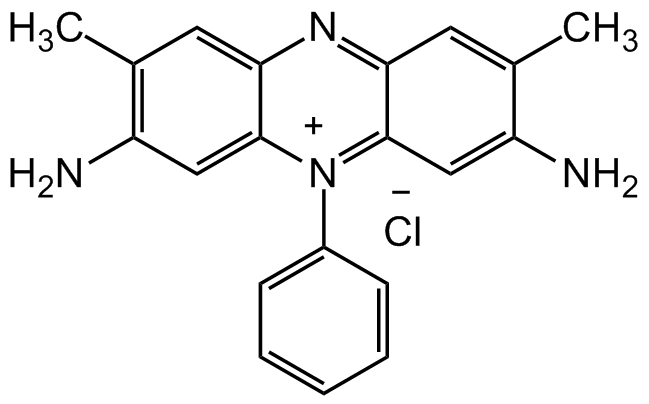Safranin O
Product Code:
CDX-S0116
CDX-S0116
Regulatory Status:
RUO
RUO
Shipping:
Ambient
Ambient
No additional charges, what you see is what you pay! *
| Code | Size | Price |
|---|
| CDX-S0116-G025 | 25 g | £84.00 |
Quantity:
Prices exclude any Taxes / VAT
Stay in control of your spending. These prices have no additional charges, not even shipping!
* Rare exceptions are clearly labelled (only 0.14% of items!).
* Rare exceptions are clearly labelled (only 0.14% of items!).
Multibuy discounts available! Contact us to find what you can save.
This product comes from: Switzerland.
Typical lead time: 7-10 working days.
Contact us for more accurate information.
Typical lead time: 7-10 working days.
Contact us for more accurate information.
- Further Information
- Documents
- References
- Show All
Further Information
Alternate Names/Synonyms:
Basic Red 2; Cotton Red; Gossypimine; Safranin T; Safranin Y; Safranin A
Appearance:
Dark red to brown powder.
CAS:
477-73-6
EClass:
32160000
Form (Short):
solid
GHS Symbol:
GHS05
Handling Advice:
Protect from light and moisture.
Hazards:
H318
InChi:
InChI=1S/C20H18N4.ClH/c1-12-8-17-19(10-15(12)21)24(14-6-4-3-5-7-14)20-11-16(22)13(2)9-18(20)23-17;/h3-11H,1-2H3,(H3,21,22);1H
InChiKey:
OARRHUQTFTUEOS-UHFFFAOYSA-N
Long Description:
Chemical. CAS: 477-73-6. Formula: C20H19ClN4. MW: 350.84. Synthetic. Redox and adsorption indicator. Employed as a biological stain used in histology, cytology and bacteriology. Biological stain commonly used as a counter stain for gram-negative bacteria in the Gram stain procedure. Has been observed to bind to DNA. In the Flemming triple stain procedure used to stain for chromosomes. In late Palaeozoic pteridosperm cuticles has shown increased contrast, emphasized cutinization differences, and enhanced the three-dimensional morphology of complex epidermal features when compared with other dyes. The compound has also been used with alcian blue in the histochemical study of the distribution and morphometric characteristics of mast cells. Also used to detect mucin and cartilage.
MDL:
MFCD00011759
Molecular Formula:
C20H19ClN4
Molecular Weight:
350.84
Package Type:
Vial
Precautions:
P280, P305+P351+P338
Product Description:
Redox and adsorption indicator. Employed as a biological stain used in histology, cytology and bacteriology. Biological stain commonly used as a counter stain for gram-negative bacteria in the Gram stain procedure. Has been observed to bind to DNA. In the Flemming triple stain procedure used to stain for chromosomes. In late Palaeozoic pteridosperm cuticles has shown increased contrast, emphasized cutinization differences, and enhanced the three-dimensional morphology of complex epidermal features when compared with other dyes. The compound has also been used with alcian blue in the histochemical study of the distribution and morphometric characteristics of mast cells. Also used to detect mucin and cartilage.
Purity:
>85% (dye content)
Signal Word:
Warning
SMILES:
CC1=C(N)C=C([N+](C2=CC=CC=C2)=C(C=C(N)C(C)=C3)C3=N4)C4=C1.[Cl-]
Solubility Chemicals:
Soluble in water (30mg/ml) or ethanol.
Source / Host:
Synthetic.
Transportation:
Non-hazardous
UNSPSC Category:
Fluorescent Reagents
UNSPSC Number:
41105331
Use & Stability:
Stable for at least 2 years after receipt when stored at RT.
Documents
References
(1) L. Rosenberg; J. Bone Joint Surg. Am. 53, 69 (1971) | (2) M. Krings; Rev. Palaeobot. Palynol. 108, 143 (2000) | (3) D. Tran, et al.; Dermatol. Surg. 26, 197 (2000) | (4) D.P. Penney, et al.; Biotech. Histochem. 77, 237 (2002) | (5) S. Gokturk & M Tuncay; Spectrochim. Acta A Mol. Biomol. Spectrosc. 59, 1857 (2003) | (6) N. Schmitz, et al.; Osteoarthritis Cartilage 18, S113 (2010) (Review)



